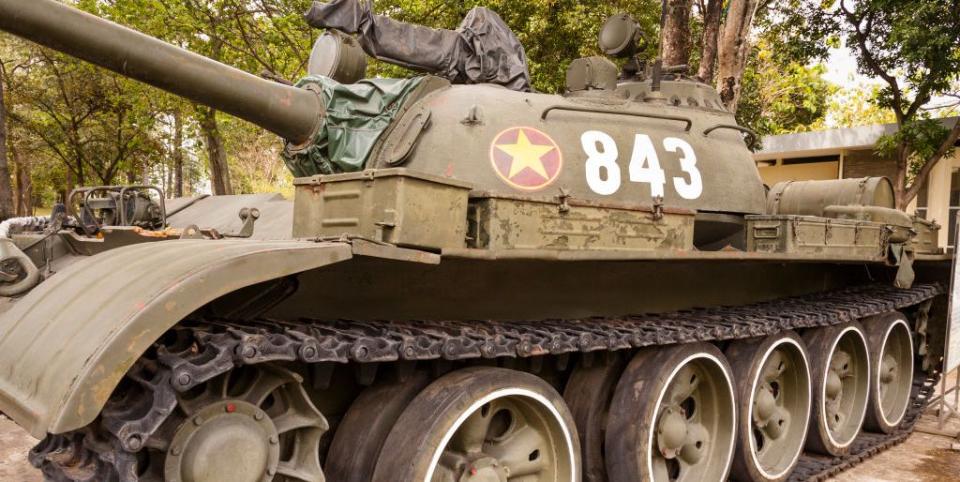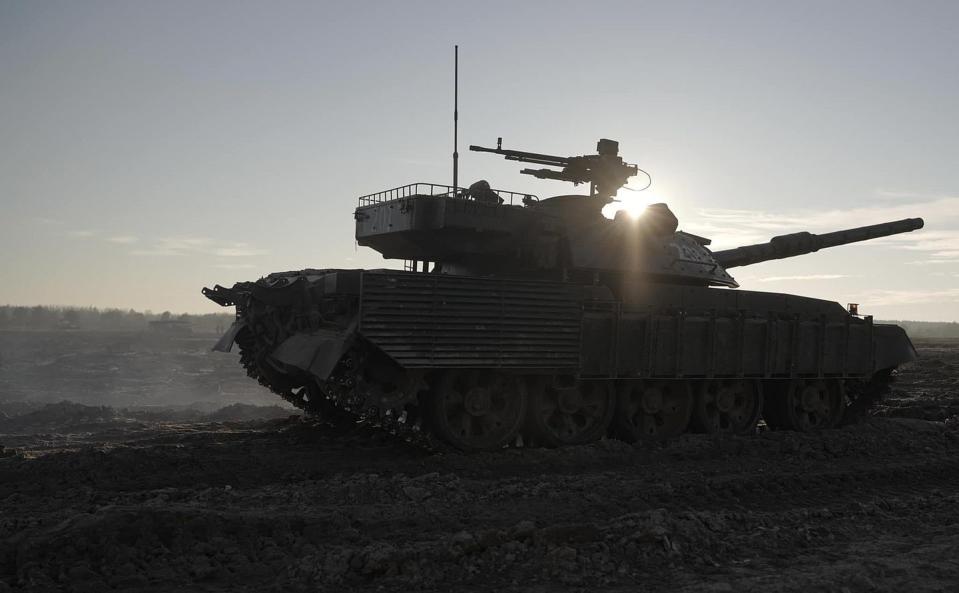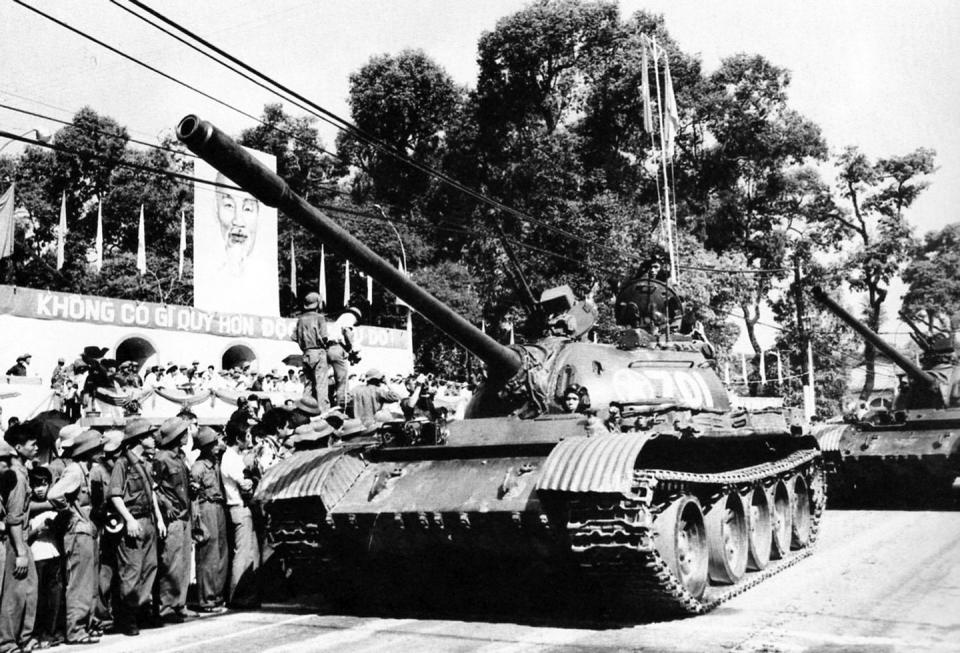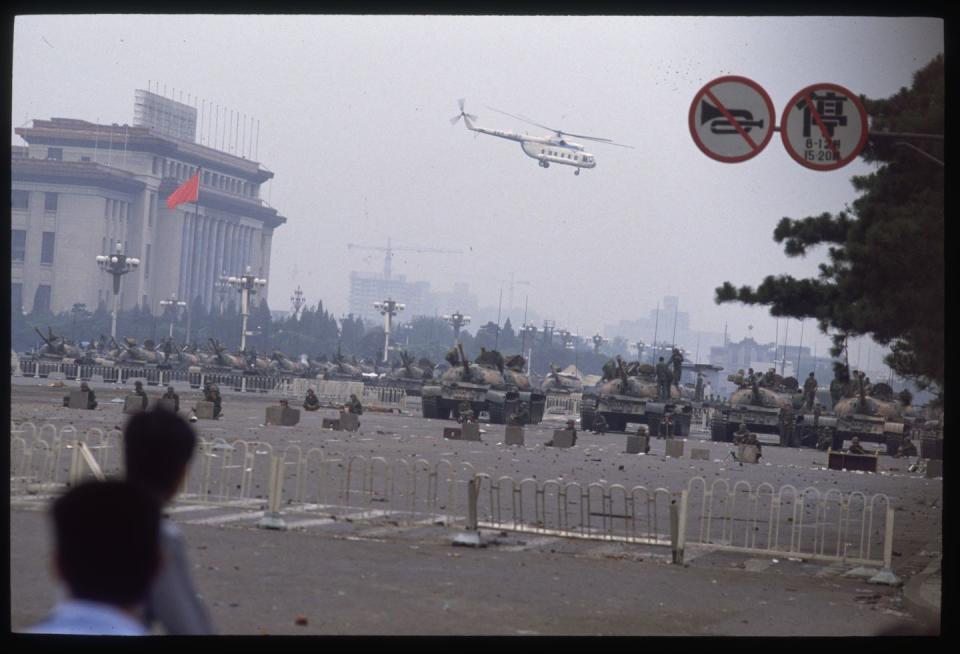As Losses Mount, Russia Is Reactivating Soviet-Era T-54 Tanks. That Says So Much.

Russia is dusting off the cobwebs from military deep storage facilities in the country’s Far East, for the first time railing un-upgraded Cold War T-54B tanks westward, possibly bound for Ukraine. Now, a video of the T-54s transported by rail has surfaced.
/2. Video of a train with old Soviet T-54/55 which was seen in Russia pic.twitter.com/p7UoBjD5ti
— Special Kherson Cat 🐈🇺🇦 (@bayraktar_1love) March 22, 2023
This news was first revealed on Wednesday by an investigative report by Conflict Intelligence Team, an independent investigative group from Russia. Formed in 2014 with a focus on exposing Russia’s initially covert war in Ukraine, its members were forced into exile after Moscow initiated its 2022 invasion.
The group posted still photos of T-54s seen transiting through the town of Arsenyev, on the southeastern tip of Russia near Vladivostok—the location of the 1295th Central Tank Repair and Storage Base. Earlier in the summer of 2022, this base also furnished T-62MV tanks that were deployed into combat in Ukraine. Though similar in appearance, the smaller T-54 can be distinguished by a visible gap between the front two road wheels not visible in its successor.
Based on satellite photos, the investigative group estimated at least 191 tanks, but possibly many more, were withdrawn from the facility between July and October 2022.
.@rferl obtained historical satellite imagery of the Arsenyev storage base. At least 191 tanks disappeared from there between July 12th and October 2nd, 2022. @planet imagery taken on Jul. 12, Aug. 19 and Oct. 2 was used for the video below. pic.twitter.com/KiqRah8E5a
— Mark Krutov (@kromark) March 22, 2023
You can see the huge number of apparently rusting tanks in this satellite photo, though keep in mind more vehicles may be housed in better condition in hangars.
The base mentioned is here:https://t.co/L042Eh3bkd
If you look to the bottom right some of the tanks stored there are not in the best condition. pic.twitter.com/Vkst9rbPwr— Arvelleg (@Arvelleg1) March 22, 2023
Like the T-62, the T-54 has a four-man crew as its gun is manually loaded, unlike the three-man crews of newer Soviet and Russian tanks like the T-72. The T-54’s sensors and mechanical fire control systems are crude by modern standards, limiting its ability to detect and hit enemies at longer distances. Furthermore, limited night-fighting capability on T-54Bs and T-55s comes via a Luna infrared search light, which risks fatally illuminating the user to enemies. The T-54’s engine power-to-weight ratio is also inferior to much heavier Western tanks, confining maximum speed to around 32 miles per hour.
Though formidably armored when they emerged in the late 1940s and 1950s, T-54s are vulnerable to all modern anti-tank weapons. In return, their D-10T 100-millimeter rifled guns would struggle to penetrate the frontal armor of modern Soviet and Western tanks, which usually exceed 450- to 500-millimeter equivalents versus kinetic rounds, or even more against shaped-charge HEAT rounds. By comparison, even Russia’s newer 3UBM11 100-millimeter sabot rounds with tungsten penetrators achieve only 280-millimeters equivalent penetration at 2 kilometers, and the 3UBM8 HEAT round blasts through 350-millimeters at any range.
To be fair, the gun’s shortcomings mostly matter when dueling other tanks, a comparatively rare form of combat in Ukraine. Outside of that, the T-54/55 still poses a deadly threat to infantry, its gun still threatens all armored vehicles short of a tank like BMP or Bradley fighting vehicles, and its front turret armor should withstand most anti-tank busting weapons, including the autocannons on IFVs.
In the kinds of a small-unit infantry actions around entrenched positions common in this phase of Russia’s war in Ukraine, fire support from even a small number of tanks can make a big difference.
Indeed, Ukraine has already beaten Russia to re-introducing to T-55 tanks, as its all-volunteer 47th Assault Brigade uses 28 T-55-based M-55S tanks donated by Slovenia. But those are very heavily upgraded with a 105-millimeter L7 gun effective against most Russian tanks, an uprated 600-horsepower engine, stabilized infrared day/night sights, digital fire control computers, laser-warning receivers, smoke grenade launchers, and blocks of explosive reactive armor (ERA) that will give it a chance to withstand infantry anti-tank rockets and missiles.

The Russian T-54B and T-54-3 identified on the train, by contrast, don’t appear much upgraded yet. The T-54-3 (or Object 137Sh) differed from the rare early production models by the flush bottom of its half-sphere turret, smoke-generating system and slightly improved TSh-2-22 gunner’ sight. It was identified in the photos by its muzzle counterweight.
The later T-54B introduced improved gun stabilization and limited night-fighting capability thanks to a ‘Luna’ infrared searchlight, but still lacks many improvements introduced on the T-55 introduced in 1958.
Moscow may invest in improving these vehicles by fitting blocks of ERA, or laminated BDD-type “eyebrow” armor already used on the T-62; by fitting new sights; or even a fire-control system capable of firing 9M117 Bastion (NATO codename AT-10 Stabber) laser-guided anti-tank missiles from the gun. This has a range of 3.4 miles and a HEAT warhead achieving 450-500 millimeters penetration, or a more formidable 600 to 750 millimeters using newer tandem-charge warhead variants.
However, given resource constraints and the urgency to move hardware to the frontline in Ukraine, pre-deployment upgrades may be more modest to save time and cost. Perhaps the outdated tanks may go to Russia Donetsk and Luhanks separatist armies or supply second-line formations assigned defensive roles, perhaps even as serving more as “moving pill boxes” rather than breakthrough tanks.
They might also be used for training, though that would be less than ideal way to prepare operating modern tanks due to their different crew configuration and lack of modern systems.
Is Russia Running Out of Tanks?
By mid-March, the Oryx military analysis website had documented media confirming Russia has lost 1,121 tanks destroyed and 656 captured or abandoned since hostilities began in 2022. That’s more tanks lost than the combined active tank fleets in the armies of Germany, France, the United Kingdom, Spain and Italy.
These losses have mostly fallen upon the inventory of modernized T-72B-series and T-80B and T-80U tanks, forcing Russia to not only fall back on older variants of those vehicles, but re-introduce the retired (but moderately upgraded) T-62M tank.
The bad news from Ukraine’s standpoint is that Russia has thousands of retired Soviet tanks in storage, primarily T-54/55s and T-62s. However, the poor condition of many such tanks means only a fraction can be reactivated quickly and affordably into operational service, if they can be at all. That surely explains why T-62Ms (some retired relatively recently after operational use in the 2008 Russo-Georgia war) were re-introduced despite Russia retaining some stocks of T-72s and T-80s, too.
A train near Rostov, 15x T-90M, 9x T-72B3 Obr.2022 and 14x T-62M’s on the other carriage. pic.twitter.com/PJpOZ0eLuj
— AFV Recognition (@AFVRec_) December 25, 2022
Russia’s Uralvagonzavod factory is also delivering newly built T-90M and up-armored T-72B3 model 2022 tanks, though these can’t be built fast enough to replace losses. Overall, the takeaway is that Russia is likely far from running out of tanks, but that as the war drags on, the quality/modernity of its tank fleet is declining and restoring stored tanks may require more and more time and money.
T-54: The Ubiquitous Cold War Warrior
The T-54 and very similar T-55 (fortified against nuclear/chemical threats) are the most extensively built tanks in history, with around 100,000 built in the Soviet Union, Poland, and Czechoslovakia, exceeding production of Soviet T-34 and U.S. Sherman tanks from World War II. They’re known for their distinctive ‘lumpy’ spherical turret armor.
When introduced after World War II, the T-54 marked an important qualitative improvement to Soviet medium tank armor and firepower. During street fighting in the 1956 Hungarian revolution, a T-54 captured by Hungarian fighters in Budapest was delivered to the British embassy, where analysts were shocked by armor with an effective thickness equivalent to 8 inches of steel on the turret front—leading to accelerated fielding of a more powerful L7 105-millimeter tank gun and beefier M60 and Chieftain tanks.
The subsequent 40-ton T-55 model introduced nuclear/biological/chemical systems to allow the crew to survive on an irradiated nuclear battlefield, a ‘turret basket’ that rotates crew in the turret, expanded and fuel and ammunition capacity, an uprated 581-horsepower diesel engine, gun stabilization for accurate shooting on the move, and an early night-fighting sight.
The type remained the mainstay of the Soviet Union’s allies and export clients even after the Red Army inducted the similar, but lengthened T-62 tank with a 115-millimeter smoothbore gun, and then T-64, T-72, and T-80 series tanks with autoloading 125-millimeter guns and three-man crews.
The T-54/55’s hull was also adapted for use in countless support vehicles: command tanks, BTS-series armored recovery vehicles, three different-types of armored bridge layers, IMR combat engineering vehicles, BMR mine-roller systems, TO-54/55 flamethrowers tanks, and ZSU-57 anti-aircraft vehicles with twin 57-millimeter autocannons.
The ubiquitous Soviet vehicle was used in countless wars across the globe (sometimes on both sides)—particularly impacting the Arab-Israeli, India-Pakistan, and Iran-Iraq conflicts, as well as the Soviet occupation of Afghanistan (where a T-55 became subject of the war drama The Beast), the North Vietnam’s capture of Saigon in 1975, and the huge mechanized battle of Cuito Cuanavale, when Cuban and Angolan T-55s battled the South African army.

Even in the 1990s through today, they played major roles in conflicts in the Balkans, Congo, Ethiopia, Iraq, Libya, Sudan, Syria, Somalia—leaving behind hundreds of destroyed hulls in their wake.
The T-54A was also reverse-engineered by China, resulting in the Type 59 tank, of which 10,000 were built and extensively exported, with combat use by Congo, Iraq, Iran, Myanmar, Pakistan and Vietnam. Infamous for their role crushing protests at Tiananmen Square in June 1989, Type 59s remain in limited service today with the People’s Liberation Army upgraded with L7-style 105-millimeter guns and fire control.

Many countries still maintain active T-54/55 fleets, or keep the type in storage. Despite their obsolescence pitted against modern missiles and armored vehicles, they remain cheap and effective facing rebel armies or state militaries that lack enough longer-range anti-tank weapons.
It was perhaps inevitable that Russia’s massive and prolonged invasion of Ukraine, which has voraciously consumed armored vehicles of all kinds, would eventually see the venerable type drawn into it. It’s nonetheless shocking that Russia is compelled to reintroduce its early-Cold War tank—even if on a limited scale—after decades of mass-producing more modern designs. That reflects the huge toll this war of choice is exacting upon Russia’s military.
You Might Also Like

 Yahoo Autos
Yahoo Autos 